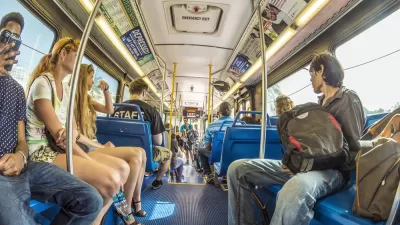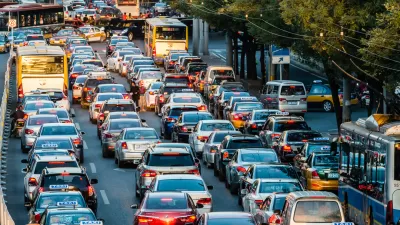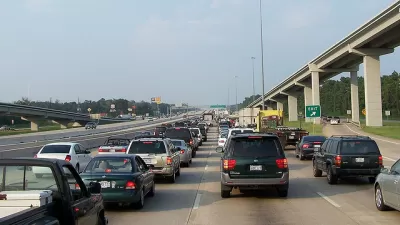A common argument in favor of building sprawl-generating roads and highways is that if we just pave over enough of the United States, we can actually reduce pollution and greenhouse gas emissions by reducing congestion. For example, a Reason Foundation press release cited a report by two University of California/Riverside engineering professors, “Real-World CO2 Impact of Traffic Congestion” (available online at http://www.cert.ucr.edu/research/pubs/TRB-08-2860-revised.pdf ). But if you read the report carefully, its policy impact is a bit more ambiguous.
 A common argument in favor of building sprawl-generating roads and highways is that if we just pave over enough of the United States, we can actually reduce pollution and greenhouse gas emissions by reducing congestion. For example, a Reason Foundation press release cited a report by two University of California/Riverside engineering professors, "Real-World CO2 Impact of Traffic Congestion" (available online at http://www.cert.ucr.edu/research/pubs/TRB-08-2860-revised.pdf ). But if you read the report carefully, its policy impact is a bit more ambiguous.
A common argument in favor of building sprawl-generating roads and highways is that if we just pave over enough of the United States, we can actually reduce pollution and greenhouse gas emissions by reducing congestion. For example, a Reason Foundation press release cited a report by two University of California/Riverside engineering professors, "Real-World CO2 Impact of Traffic Congestion" (available online at http://www.cert.ucr.edu/research/pubs/TRB-08-2860-revised.pdf ). But if you read the report carefully, its policy impact is a bit more ambiguous.
Using complicated modeling, the paper purports to list CO2 impacts for thousands of freeway trips in congested Los Angeles. According to the authors, whenever congestion causes cars to travel less than 45 mph, CO2 emissions increase. Thus, reducing congestion to prevent bumper-to-bumper traffic will reduce emissions. But the same paper asserts that "If moderate congestion brings average speeds down from a free-flow speed of about 65 mph to a slower speed of 45 to 50 mph, this moderate congestion can actually lower CO2 emissions." (Id., p. 9). Moreover, CO2 emissions increase quite rapidly at speeds above 65 mph. (Id., p. 11).
So do these apparent facts support an avalanche of new or widened freeways? Not necessarily. On most freeways most of the time, people travel at speeds far above the 45 mph ideal. The paper points out that even in notoriously congested Los Angeles County, "speeds around 65 to 70 mph dominate." (Id., p. 13).
It logically follows that even in Los Angeles, it is unclear whether a freeway "improvement" would do more good or more harm. Assuming that the improvement actually reduced congestion,* some highly polluting bumper-to-bumper traffic would be eliminated (good news) but some 45-50 mph trips might be turned into more-polluting 70 mph trips (not-so-good news).
It may also follow that where congestion is less frequent (for example, my current residence in Jacksonville, Fla.) an improved highway would be even more likely to increase pollution than in Los Angeles. Why? Because in Jacksonville, there are fewer slow trips for a road improvement to eliminate. Thus, a freeway widening would be more likely than in Los Angeles to lead to more "bad news" trips (in which speeds increased from 45-50 mph to 70 or more mph) than "good news" trips (in which speeds increased to 45-50 mph from a lower speed).
*Given the amount of controversy over "induced traffic" (the idea that wider roads tempt people to drive more, thus eliminating congestion gains over the long run), I am not sure this is the case.

Manufactured Crisis: Losing the Nation’s Largest Source of Unsubsidized Affordable Housing
Manufactured housing communities have long been an affordable housing option for millions of people living in the U.S., but that affordability is disappearing rapidly. How did we get here?

Americans May Be Stuck — But Why?
Americans are moving a lot less than they once did, and that is a problem. While Yoni Applebaum, in his highly-publicized article Stuck, gets the reasons badly wrong, it's still important to ask: why are we moving so much less than before?

Research Shows More Roads = More Driving
A national study shows, once again, that increasing road supply induces additional vehicle travel, particularly over the long run.

Judge Halts Enforcement of Anti-Homeless Laws in Grants Pass
The Oregon city will be barred from enforcing two ordinances that prosecute unhoused residents until it increases capacity and accessibility at designated camping sites.

Advancing Sustainability in Los Angeles County Schools
The Los Angeles County Office of Education’s Green Schools Symposium brings together educators, students, and experts to advance sustainability in schools through innovative design, climate resilience strategies, and collaborative learning.

Using Old Oil and Gas Wells for Green Energy Storage
Penn State researchers have found that repurposing abandoned oil and gas wells for geothermal-assisted compressed-air energy storage can boost efficiency, reduce environmental risks, and support clean energy and job transitions.
Urban Design for Planners 1: Software Tools
This six-course series explores essential urban design concepts using open source software and equips planners with the tools they need to participate fully in the urban design process.
Planning for Universal Design
Learn the tools for implementing Universal Design in planning regulations.
City of Moreno Valley
Institute for Housing and Urban Development Studies (IHS)
City of Grandview
Harvard GSD Executive Education
NYU Wagner Graduate School of Public Service
City of Cambridge, Maryland
Newport County Development Council: Connect Greater Newport






























